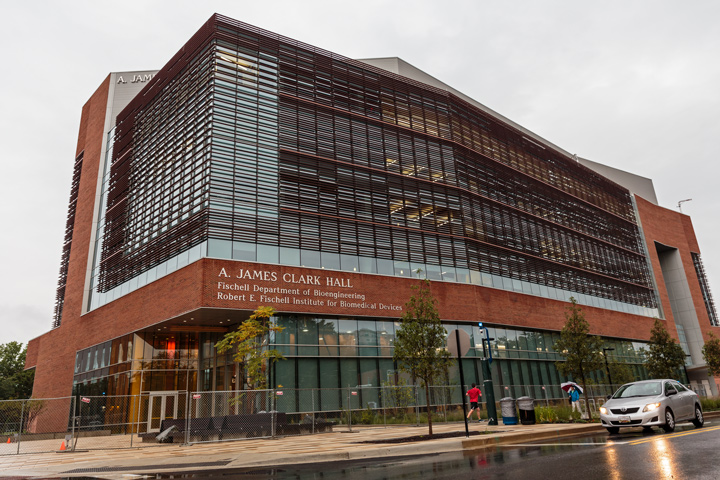Clark Hall opened to University of Maryland students and faculty on Jan. 19 after its completion in December.
The $169.1 million building, which is home to this university’s bioengineering department, is hosting classes for the spring semester, and Facilities Management has moved in classroom furniture and begun installing laboratory equipment. An estimated 10 percent of the total laboratory equipment for the building has been installed as of Jan. 30, Department Chair John Fisher said.
Some laboratory equipment and instruments can’t be moved into the building until the end of the semester, as they are currently being used by faculty and students across five different buildings on the campus. Other projects within the structure — which was originally projected to be finished by June 2017 — are also underway, including work on its internal technology and audiovisual components.
“Faculty and students are conducting experiments in four or five different buildings that are too sensitive to move until the projects are completed and they have collected their results,” said Darryll Pines, dean of the engineering school.
[Read more: The new home of UMD’s bioengineering department will be ready this month]
Facilities management staffers are also commissioning the building, said Bill Olen, capital projects director. The process, which entails testing the building’s mechanical and electrical systems to ensure they meet the standards of its contracts, can take up to a year to finish with a structure the size of Clark Hall, but classes can still use it at the same time, Olen said.
Students also see the potential of the new building and its amenities, which include 184,000 square feet of facilities. Almost 40,000 square feet of the building are devoted to laboratories, and roughly 25,000 square feet of the space are reserved for research for faculty and graduate students. The structure also has a prototyping/fabrication lab that produces advanced manufacturing and 3-D printing.
“I think [the facilities of Clark Hall] could promote more self-exploring projects where students do their own research and work by themselves,” said Alex Smith, a design engineer and lab coordinator for Terrapin Works, which is a collection of engineering resources for students. “Plus, every time you get new facilities, it helps attract new faculty, more research space, more funding, and then better graduates.”
The first two floors of Clark Hall will be design spaces for capstone projects across all disciplines within the engineering school, and the third and fourth floors are dedicated to the bioengineering department. The fifth floor is slated for research facilities for the bioengineering department and the new Robert E. Fischell Institute for Biomedical Devices.
Clark Hall is named for Alfred James Clark, a 1950 alumnus of this university and the late owner of Clark Construction Group, which has built 26 other buildings on the campus. In October, this university announced it would receive a $219.5 million donation from the A. James and Alice B. Clark Foundation that would support various need-based scholarships, programs, graduate fellowships and developments for this university and its engineering school.
Smith said he noticed a few small problems within the new Clark Hall, such as the failure of some door closures to latch and inconvenient placement of projection screens in classrooms.
Senior chemical engineering major Cameron Connolly said the placement of whiteboards, the projection screen and the door in one of his classrooms in Clark Hall made it difficult for his professor to handle both her PowerPoint and the whiteboard. Others have concerns the classrooms’ glass walls will hinder students’ ability to stay focused.
[Read more: After its dedication, UMD’s new bioengineering building is ready for spring classes]
“Some of our professors are really smart, but they struggle to keep kids’ attention,” said Smith. “If they’re already struggling to keep students’ attention, it’s not going to be the best to have glass walls where you can see all the movement outside.”
Arnaud Trouvé, who teaches ENFP426: Computational Methods in Fire Protection in Clark Hall this semester, said more space in the new classrooms has helped him combine the use of whiteboards and technology. The whiteboards cover almost the entirety of the walls in the classrooms in Clark, and this additional space helps Trouvé alternate between the whiteboard and his PowerPoint without having to close or move the projection screen.
Senior civil engineering major Jessica Schroeder thinks the new building will help facilitate communication between engineering students and help them during group projects. Boosting engagement between all engineering students was also one of Pines’ goals for the building, he said.
“One problem we have today is that our college is divided into eight departments, and all the capstone design experiments are done by discipline,” Pines said. “[Clark Hall] allows us to have chemical engineering [and] mechanical engineering students working in the same building and leverage their talents to develop a more complicated system that uses all their talents in different disciplines together.”



